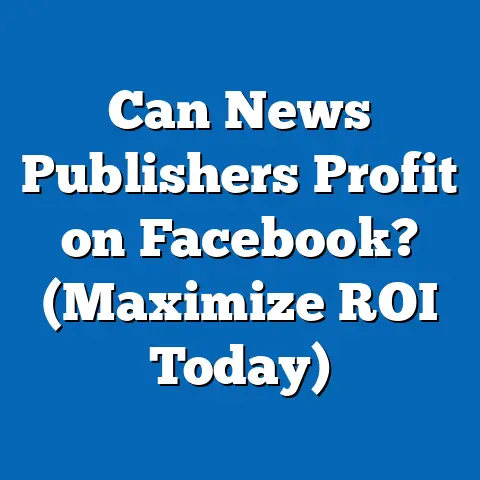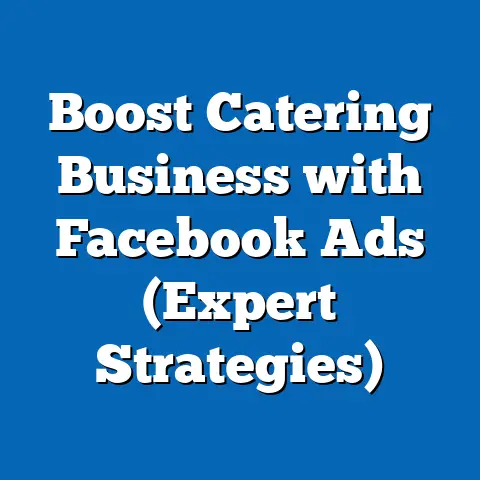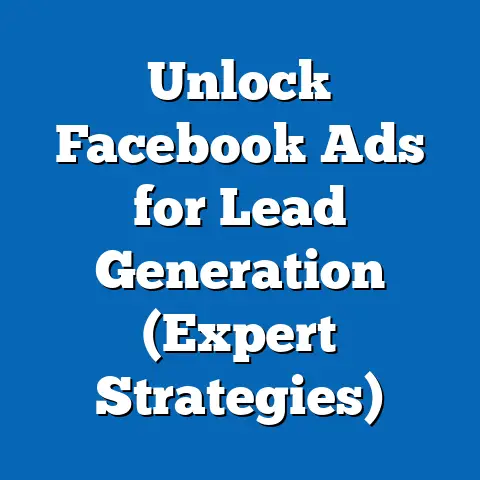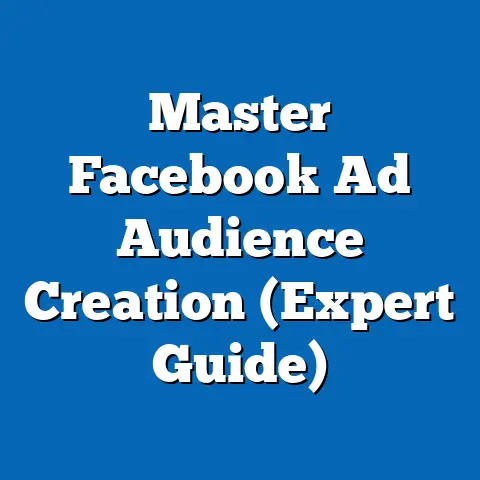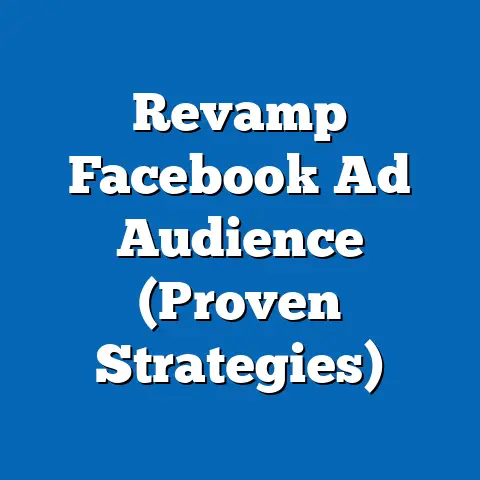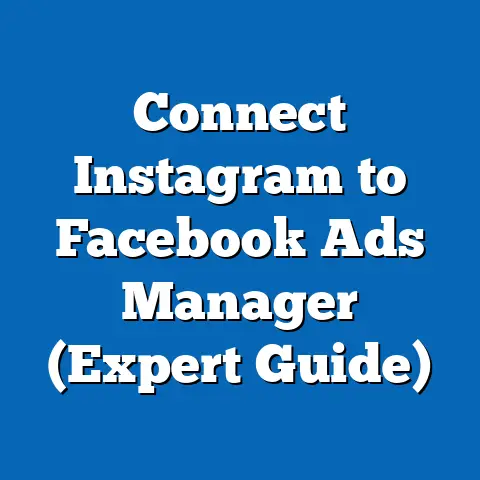Unlock Profit Potential with Facebook Ads (Game-Changer)
Imagine Sarah, a passionate baker, standing in her cozy bakery, surrounded by the aroma of freshly baked bread and the sight of perfectly decorated cakes. Her local bakery has garnered a loyal following through word of mouth, a testament to her skills and dedication. Yet, despite her best efforts, Sarah’s revenue has plateaued. She watches potential customers pass by, a sense of uncertainty weighing on her. She knows her bakery is special, but how can she reach more people and unlock its true potential?
One day, while scrolling through her own Facebook feed, Sarah stumbles upon an ad promising to help local businesses like hers reach new heights. Intrigued, yet skeptical, she clicks. This ad opens her eyes to the world of Facebook advertising, a world that could potentially transform her business from a local favorite to a thriving venture.
My aim in this guide is to show you, just like Sarah, how Facebook ads can be a game-changer for your business. I’ll break down the complexities, share strategies, and provide actionable steps to help you unlock your profit potential through the power of Facebook advertising. I’ve seen firsthand how businesses of all sizes have transformed their fortunes with the right approach, and I’m excited to share that knowledge with you.
Understanding Facebook Ads
Let’s start with the basics. What exactly are Facebook Ads, and how do they work?
Facebook Ads are paid messages that businesses create and display to users on Facebook, Instagram, Messenger, and the Audience Network. Unlike organic posts that rely on your existing followers and Facebook’s algorithm, ads allow you to reach a much wider audience based on specific targeting criteria.
Think of it as a digital billboard, but instead of hoping the right people drive by, you can choose exactly who sees your message. It’s this level of control and precision that makes Facebook Ads so powerful.
Types of Facebook Ads
Facebook offers a variety of ad formats to suit different business goals and creative styles. Here’s a rundown of the most common types:
- Image Ads: These are single-image ads that are simple yet effective. They’re great for showcasing a product or service with a visually appealing image and concise copy. I’ve found that high-quality, professionally shot images tend to perform best.
- Video Ads: Video ads can capture attention and convey more information than static images. They’re perfect for demonstrating how a product works, sharing customer testimonials, or telling a compelling brand story. I personally love using short, engaging video ads to highlight unique features.
- Carousel Ads: Carousel ads allow you to showcase multiple images or videos within a single ad unit. Each image or video can have its own headline, description, and link. This format is excellent for highlighting different features of a product or telling a story in a sequence. I’ve seen carousel ads work wonders for e-commerce businesses showcasing their product range.
- Slideshow Ads: Slideshow ads are similar to video ads but created using a series of images. They’re a cost-effective way to create engaging content without the need for video production. I often recommend slideshow ads to businesses with limited video resources.
- Collection Ads: These ads are designed for mobile shoppers and allow users to browse and purchase products directly within the Facebook app. They typically feature a main image or video with a selection of related products below. I find collection ads particularly effective for driving e-commerce sales.
- Lead Ads: Lead ads are designed to collect leads directly from Facebook users. They feature a form that users can fill out without leaving the platform. This format is ideal for building your email list or generating leads for your sales team. I’ve used lead ads extensively for clients offering services like consulting or coaching.
- Instant Experience Ads: Also known as Canvas ads, these are full-screen ads that load instantly on mobile devices. They offer an immersive and interactive experience that can showcase your brand and products in a unique way. I’ve seen instant experience ads create a lasting impression on users.
The Power of Targeting
The true power of Facebook Ads lies in its sophisticated targeting options. You can target users based on a wide range of criteria, including:
- Demographics: Age, gender, location, education, relationship status, job title, and more. This allows you to reach very specific segments of the population.
- Interests: Hobbies, interests, pages they like, and groups they belong to. This helps you target users who are likely to be interested in your products or services.
- Behaviors: Purchase history, device usage, travel habits, and other online behaviors. This provides insights into users’ actions and preferences.
- Custom Audiences: You can upload your own customer data (email addresses, phone numbers) to create custom audiences. This allows you to target your existing customers or create lookalike audiences (users who share similar characteristics to your customers). I’ve found that lookalike audiences are incredibly effective for expanding your reach.
- Retargeting: Target users who have previously interacted with your website, app, or Facebook page. This is a powerful way to re-engage potential customers who have shown interest in your brand. I always recommend retargeting campaigns to clients looking to boost conversions.
By combining these targeting options, you can create highly targeted ad campaigns that reach the right people with the right message at the right time. This is what separates Facebook Ads from traditional advertising methods and makes them so effective.
Takeaway: Facebook Ads offer a powerful and versatile way to reach your target audience. Understanding the different ad formats and targeting options is crucial for creating successful campaigns.
The Game-Changing Impact of Facebook Ads
Now that you understand the basics, let’s dive into the real impact Facebook Ads can have on your business. It’s not just about running ads; it’s about leveraging them strategically to achieve your specific goals.
Statistics Speak Volumes
The numbers don’t lie. Facebook is the most widely used social media platform, with billions of active users. Here are some key statistics that highlight the potential of Facebook Ads:
- Vast Reach: Facebook boasts over 2.9 billion monthly active users (as of 2023). This massive audience provides unparalleled reach for your ads.
- High Engagement: Facebook users spend an average of 33 minutes per day on the platform. This presents ample opportunities to capture their attention with engaging ads.
- Mobile Dominance: Over 98% of Facebook users access the platform via mobile devices. This underscores the importance of optimizing your ads for mobile viewing.
- Ad Revenue: Facebook generates billions of dollars in advertising revenue each quarter. This demonstrates the effectiveness of the platform for businesses of all sizes.
Real-World Success Stories
Beyond the statistics, the real magic lies in the success stories of businesses that have transformed their fortunes with Facebook Ads. Here are a few examples:
- Dollar Shave Club: This company disrupted the razor industry by using clever video ads on Facebook to build brand awareness and drive subscriptions. Their humorous and relatable ads resonated with their target audience, leading to explosive growth.
- Warby Parker: This eyewear company used Facebook Ads to reach a wider audience and offer a convenient online shopping experience. They utilized high-quality product images and targeted ads to drive traffic to their website and increase sales.
- MVMT Watches: This watch company leveraged Facebook Ads to build a strong brand presence and drive e-commerce sales. They used engaging video ads and targeted advertising to reach their ideal customer base, resulting in rapid growth and profitability.
- Many Chat: One of my personal clients, Many Chat, used Facebook ads to grow their customer base and increase their revenue. They used lead magnet ads to generate quality leads and retargeting ads to convert website visitors into paying customers.
These are just a few examples of how Facebook Ads can be a game-changer for businesses. The key is to understand your target audience, create compelling ads, and continuously optimize your campaigns based on data-driven insights.
Understanding ROAS
One of the most important metrics to consider when running Facebook Ads is Return on Ad Spend (ROAS). ROAS measures the revenue generated for every dollar spent on advertising. A high ROAS indicates that your ads are performing effectively and generating a positive return on investment.
For example, if you spend $100 on Facebook Ads and generate $500 in revenue, your ROAS would be 5:1 or 500%. This means that for every dollar you spend, you’re generating $5 in revenue.
The ideal ROAS will vary depending on your industry, business model, and profit margins. However, a general rule of thumb is to aim for a ROAS of at least 3:1 to ensure that your ads are profitable.
Takeaway: Facebook Ads can have a significant impact on your business, driving brand awareness, generating leads, and increasing sales. Understanding metrics like ROAS is crucial for measuring the effectiveness of your campaigns.
Crafting a Winning Facebook Ad Strategy
Creating a successful Facebook Ad campaign requires careful planning and execution. It’s not enough to simply throw up an ad and hope for the best. You need a well-defined strategy that aligns with your business goals and target audience.
Setting Clear Objectives
The first step in crafting a winning Facebook Ad strategy is to define your objectives. What do you want to achieve with your ads? Are you looking to:
- Increase Brand Awareness: Reach a wider audience and build recognition for your brand.
- Generate Leads: Collect contact information from potential customers.
- Drive Website Traffic: Increase the number of visitors to your website.
- Boost Sales: Increase the number of products or services you sell.
- Promote an Event: Get people to attend your event.
Your objectives will determine the type of ad you create, the targeting options you use, and the metrics you track. Be specific and measurable when setting your objectives. For example, instead of saying “increase brand awareness,” say “increase brand awareness by 20% in the next quarter.”
Compelling Ad Copy and Visuals
Once you’ve defined your objectives, you need to create compelling ad copy and visuals that resonate with your target audience. Your ad copy should be clear, concise, and persuasive. It should highlight the benefits of your product or service and include a strong call to action.
Your visuals should be high-quality and visually appealing. Use images or videos that capture attention and convey your brand’s message. Make sure your visuals are optimized for mobile viewing.
Here are some tips for creating compelling ad copy and visuals:
- Know Your Audience: Understand their needs, wants, and pain points.
- Highlight Benefits: Focus on how your product or service will improve their lives.
- Use Strong Headlines: Grab their attention with a captivating headline.
- Include a Call to Action: Tell them what you want them to do (e.g., “Shop Now,” “Learn More,” “Sign Up”).
- Use High-Quality Images and Videos: Make sure your visuals are visually appealing and optimized for mobile viewing.
- Keep it Concise: Get to the point quickly and avoid unnecessary jargon.
The Power of A/B Testing
A/B testing, also known as split testing, is a crucial component of any successful Facebook Ad strategy. It involves creating multiple versions of your ads and testing them against each other to see which performs best.
You can A/B test different elements of your ads, such as:
- Headlines: Test different headlines to see which generates the most clicks.
- Images/Videos: Test different visuals to see which captures the most attention.
- Ad Copy: Test different ad copy to see which is most persuasive.
- Call to Actions: Test different calls to action to see which drives the most conversions.
- Targeting Options: Test different targeting options to see which reaches the most relevant audience.
By A/B testing your ads, you can identify the most effective elements and continuously optimize your campaigns for better performance. I recommend A/B testing regularly to stay ahead of the curve and maximize your ROI.
Takeaway: Crafting a winning Facebook Ad strategy involves setting clear objectives, creating compelling ad copy and visuals, and A/B testing your ads to optimize performance.
Budgeting for Success
One of the biggest questions businesses have when starting with Facebook Ads is: “How much should I spend?” The answer to this question depends on a variety of factors, including your business goals, target audience, and budget constraints.
Daily vs. Lifetime Budgets
Facebook offers two main budgeting options:
- Daily Budget: This is the average amount you’re willing to spend per day on your ad campaign. Facebook will aim to spend this amount each day, but it may fluctuate slightly depending on performance.
- Lifetime Budget: This is the total amount you’re willing to spend on your ad campaign over its entire duration. Facebook will aim to spend this amount evenly over the campaign’s duration.
The choice between daily and lifetime budgets depends on your campaign goals and how much control you want over your ad spend. I generally recommend using daily budgets for ongoing campaigns and lifetime budgets for campaigns with a specific end date.
Determining the Right Budget
There’s no one-size-fits-all answer to the question of how much you should spend on Facebook Ads. However, here are some factors to consider when determining your budget:
- Your Business Goals: What do you want to achieve with your ads? Are you looking to generate leads, drive website traffic, or boost sales? Your budget should align with your goals.
- Your Target Audience: How large is your target audience? The larger your audience, the more you’ll need to spend to reach them.
- Your Industry: How competitive is your industry? The more competitive your industry, the more you’ll need to spend to stand out.
- Your Budget Constraints: How much money can you realistically afford to spend on advertising? Be realistic and don’t overextend yourself.
As a starting point, I often recommend setting a daily budget of at least $5-$10 per ad set. This will give you enough data to start optimizing your campaigns. As you gain more experience and see positive results, you can gradually increase your budget.
Effective Ad Spend Allocation
Once you’ve determined your overall budget, you need to allocate it effectively across different campaigns and audiences. Here are some tips for effective ad spend allocation:
- Prioritize Your Best Performing Campaigns: Focus your budget on the campaigns that are generating the best results.
- Allocate Budget Based on Audience Size: Allocate more budget to larger audiences and less budget to smaller audiences.
- Test Different Audiences: Experiment with different targeting options to see which performs best.
- Monitor Your Results: Continuously monitor your ad performance and adjust your budget accordingly.
Monitoring and Adjusting
Budgeting for Facebook Ads is not a one-time task. You need to continuously monitor your ad performance and adjust your budget based on the results. Pay attention to metrics like cost per click (CPC), cost per conversion (CPC), and return on ad spend (ROAS).
If you see that a campaign is performing well, consider increasing its budget. If a campaign is underperforming, consider decreasing its budget or pausing it altogether.
Takeaway: Budgeting for Facebook Ads requires careful planning and continuous monitoring. Determine your budget based on your business goals, target audience, and budget constraints. Allocate your budget effectively across different campaigns and audiences, and continuously monitor your ad performance to optimize your spend.
Analyzing and Measuring Success
Running Facebook Ads is not just about setting up campaigns and letting them run. It’s about continuously analyzing your results and making data-driven decisions to optimize your performance.
Key Metrics to Track
There are several key metrics you should track when running Facebook Ads, including:
- Impressions: The number of times your ad was shown to users.
- Reach: The number of unique users who saw your ad.
- Clicks: The number of times users clicked on your ad.
- Click-Through Rate (CTR): The percentage of users who saw your ad and clicked on it.
- Cost Per Click (CPC): The average cost you paid for each click on your ad.
- Conversions: The number of users who took a desired action after seeing your ad (e.g., making a purchase, filling out a form).
- Cost Per Conversion (CPA): The average cost you paid for each conversion.
- Return on Ad Spend (ROAS): The revenue generated for every dollar spent on advertising.
- Engagement Rate: The percentage of users who interacted with your ad (e.g., liking, commenting, sharing).
These metrics provide valuable insights into the performance of your ads and help you identify areas for improvement.
Facebook Ads Manager and Insights
Facebook provides a powerful suite of tools for measuring the effectiveness of your campaigns, including Ads Manager and Insights.
- Ads Manager: This is the main interface for creating, managing, and analyzing your Facebook Ads. It provides detailed data on your ad performance, including impressions, reach, clicks, conversions, and more.
- Insights: This tool provides more in-depth data on your audience, including demographics, interests, and behaviors. It helps you understand who is seeing your ads and how they are responding to them.
By using Ads Manager and Insights, you can gain a deeper understanding of your audience and optimize your campaigns for better results.
Data-Driven Refinement
The key to success with Facebook Ads is to continuously refine your strategies based on data-driven insights. Analyze your ad performance regularly and identify areas for improvement.
For example, if you see that your CTR is low, consider testing different headlines or images. If you see that your CPA is high, consider testing different targeting options or ad copy.
By continuously refining your strategies based on data, you can improve your ad performance and maximize your ROI.
Takeaway: Analyzing and measuring your results is crucial for success with Facebook Ads. Track key metrics, use Facebook Ads Manager and Insights, and continuously refine your strategies based on data-driven insights.
Overcoming Common Challenges
While Facebook Ads can be a powerful tool for businesses, it’s not without its challenges. Here are some common pitfalls that businesses face when starting with Facebook Ads, along with insights on how to overcome them:
Ad Fatigue
Ad fatigue occurs when your target audience becomes tired of seeing the same ads over and over again. This can lead to a decrease in engagement and performance.
To overcome ad fatigue, try the following:
- Rotate Your Ads Regularly: Create new ads with fresh copy and visuals.
- Target Different Audiences: Expand your targeting to reach new users.
- Use Different Ad Formats: Experiment with different ad formats to keep things interesting.
- Pause and Refresh: Pause your campaigns for a few days and then relaunch them with new ads.
Poor Targeting
Poor targeting can lead to wasted ad spend and low engagement. Make sure you’re targeting the right audience with the right message.
To improve your targeting, try the following:
- Define Your Target Audience: Understand their demographics, interests, and behaviors.
- Use Custom Audiences: Target your existing customers or create lookalike audiences.
- Test Different Targeting Options: Experiment with different targeting options to see which performs best.
- Exclude Irrelevant Audiences: Exclude users who are not likely to be interested in your products or services.
Lack of Creativity
Boring or uninspired ads can fail to capture attention and generate results. Make sure your ads are visually appealing and engaging.
To improve your creativity, try the following:
- Use High-Quality Images and Videos: Make sure your visuals are visually appealing and optimized for mobile viewing.
- Tell a Compelling Story: Use your ads to tell a story that resonates with your target audience.
- Highlight Benefits: Focus on how your product or service will improve their lives.
- Use Humor: If appropriate for your brand, use humor to capture attention.
Staying Updated
Facebook’s advertising platform is constantly evolving, with new features and algorithm changes being introduced regularly. It’s important to stay updated with the latest trends and best practices.
To stay updated, try the following:
- Follow Facebook’s Official Blog: Stay informed about new features and updates.
- Read Industry Blogs and Articles: Keep up with the latest trends and best practices.
- Attend Webinars and Conferences: Learn from experts in the field.
- Experiment and Test: Continuously experiment with new features and strategies to see what works best for your business.
Takeaway: Overcoming common challenges requires ongoing education, adaptation, and a willingness to experiment. Stay updated with the latest trends and best practices, and continuously refine your strategies based on data-driven insights.
Sarah’s Transformation
Let’s return to Sarah, the passionate baker we met at the beginning of this journey. After implementing a well-crafted Facebook ad strategy, Sarah’s bakery undergoes a remarkable transformation.
Her targeted ads, showcasing her delectable pastries and inviting atmosphere, begin to appear in the feeds of local residents who share interests in food, baking, and supporting local businesses. The ads are visually stunning, featuring mouth-watering images of her signature cakes and freshly baked bread.
As a result, Sarah’s bakery sees a surge in foot traffic. New customers, drawn in by the captivating ads, flock to her bakery to experience the magic for themselves. But the impact goes beyond just increased sales.
Sarah also builds a robust online community. Her Facebook page becomes a hub for local foodies, where she shares recipes, behind-the-scenes glimpses of her baking process, and engaging content that keeps her audience coming back for more.
The emotional impact of her success is profound. Sarah, once weighed down by uncertainty, now radiates confidence and joy. Her bakery is no longer just a local favorite; it’s a thriving venture that brings happiness to her community.
Sarah’s story underscores the power of Facebook advertising. With the right approach, any small business can unlock its profit potential and achieve its dreams. Facebook Ads are not just a marketing tool; they are a game-changer in today’s digital landscape.
So, are you ready to transform your business like Sarah did? Take the first step today and unlock the profit potential of Facebook Ads. The sweet taste of success awaits!

